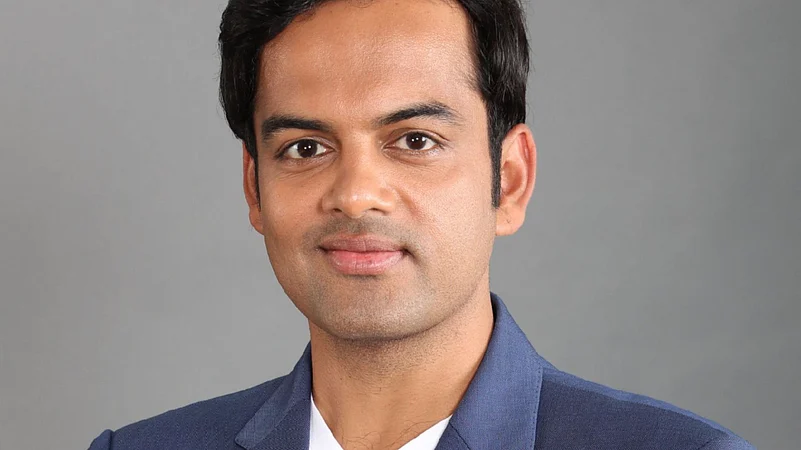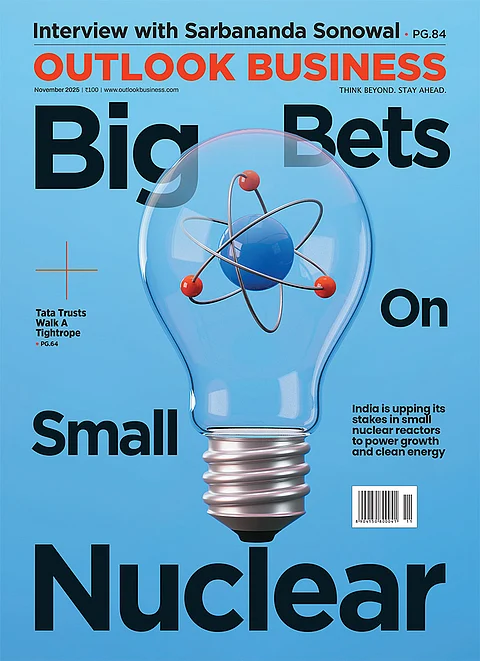
In an interaction with Outlook Business, Damani shares his views on the current funding environment
He also calls out "tourist founders"—entrepreneurs who started companies only because capital was easy
He further adds that the ability to generate high alpha there has reduced, and the real alpha today is in early-stage investing
Start-up funding is going through a tough phase in India. Seed deals have plummeted to the 45-65 deals per month range from the usual 100-plus, while ‘graduation rates’ of companies from seed to Series A have collapsed from 13% to a dismal 5%. Yet Anirudh Damani, Managing Partner at Artha Venture Fund, is having no trouble raising funds. His latest, Artha Select Fund, ended up raising nearly Rs 500 crore, far outdoing the target of Rs 330 crore.
In an interaction with Outlook Business, Damani shares his views on the current funding environment, and why he is bucking the overall trend to shift away from late-stage and pre-IPO deals to early stage companies.
“Eventually, money moves to where the best risk-adjusted returns are. And right now, that’s clearly in seed to Series A. That’s why we’re exiting our late-stage portfolio,” Damani says. He also calls out "tourist founders"—entrepreneurs who started companies only because capital was easy, explaining why the current squeeze amounts to necessary correction.
From Bengal's old-money families embracing venture capital to the surge in renewable investments and why AI monetization will follow Facebook's playbook rather than subscription models, Damani shares his insights on a variety of topics in this interview.
Edited Excerpts
Artha Select Fund has overshot its original target of Rs 330 crore by raising over Rs 432 crore. What are the immediate deployment plans, and how will this fund differ from earlier ones?
After announcing our final close, we overshot our target again. We ended up getting a lot more commitments after the final close, so the final number is going to be closer to Rs 500 crore.
That being said, the way we are looking at deploying the capital is this: Artha Venture Fund operates from the seed to Series A stage. It takes about three to three and a half years to take a company from seed to Series A. The winners from that stage are the ones we double down on through the Artha Select Fund. You filter your winners from your seed investments, and when they reach Series B, when they have broken out and require growth capital, that is when we invest from the Artha Select Fund. It is essentially a winners-only strategy.
Read: Bira 91’s Japanese Investor Kirin Eyes Exit Amid Deepening Losses, Employee Complaints
This also provides our LPs with two options. They can choose the higher-risk path where they are willing to wait five to eight years for an exit, which is what Artha Venture Fund typically offers. Or they can opt for the Artha Select Fund, which invests in companies that are already market leaders and have performed well under the SCOUT framework that we use. Some are comfortable with waiting five to eight or even ten years and are looking for 100x to 200x returns from individual investments. That segment aligns with Artha Venture Fund. With the Artha Select Fund, you will not get a 100x exit. The best scenarios may deliver 10x to 20x, but the journey from investment to exit is much faster than in a traditional venture fund.
In terms of your check sizes, you’ve mentioned that you write larger checks as companies progress. Will your check sizes remain the same, now that the fund is larger?
Originally, with the Rs 330 crore fund, the target was Rs 15 crore. Then it increased to Rs 20 crore with the green shoe, and now it stands at Rs 25 crore per round. So at Series B we will do Rs 25 crore, and at Series C we will also do Rs 25 crore.
You also have a strong focus on renewable energy investments. At a time when foreign leaders are dismissing climate concerns, there was early skepticism that capital flowing into renewables would slow down. But that is not happening.
We invest in renewable energy from our own treasury, not the fund, because it gives us long-term cash flows at the family office or AMC level. The cost of setting up renewable plants has dropped sharply. A 100 MW project that cost Rs 1,200–1,800 crore fifteen years ago now costs around Rs 300–350 crore. Land requirements have also halved from about 500 acres to 250 acres. With scale and innovation, performance has improved and adoption has grown.
As an investment, they are very attractive. Renewable projects in India deliver 16%–20% percent IRR over 20 years, almost like a high-quality bond. With interest rates falling, investors are naturally moving toward yield-generating assets like renewables.
Coming to the late -stage portfolio, you have mentioned earlier that you plan to continue selling from your late -stage portfolio as valuations no longer align with reality.
Maybe I should correct my earlier statement. What we are seeing is that the IRR growth in our late-stage portfolio, from here onward, will likely be in the range of 20 to 25 percent annualised, given the valuations they are already at.
In contrast, the early-stage portfolio we are building now is far more interesting. For several quarters we have been tracking something called the graduation rate.
In public markets, we often use PE ratios to judge whether the market is overheated or in a bubble. When PE is very high, we call it a bubble. When it is very low, we call it a bear market.
But in early-stage venture investing, there is no such indicator, because there are no earnings and therefore no PE. So we kept asking ourselves: how do we know when it is the right time to be aggressive and when to be cautious as contrarian investors?
Read: Groww CEO Lalit Keshre Joins India’s Billionaire Club after Blockbuster IPO Debut
That is when we started analysing graduation rates. In simple terms, we track what percentage of companies in a cohort move from seed to Series A within a defined period. We chose 36 months as the benchmark window. Historically, across 16,000 rounds we analysed, the typical graduation rate is about 13 percent. That means one in eight seed-funded companies becomes a Series A company within three years.
During the peak years of 2022, and similarly in 2019, that graduation rate jumped from 13 percent to around 30–31 percent. That meant one out of three companies was raising a Series A. The quality of companies did not suddenly improve. It was just over-exuberance in the ecosystem. And just like any bull market, such periods are always followed by a correction.
If you now look at where we are: since 2015, India has consistently seen at least 100 seed deals a month, even in weak markets, until the last few months. Since then, the average seed deal count has dropped to around 70 deals a month. In September it was 67. In August, just 47. Even in 2015, when the ecosystem was far less developed, we still saw 100 to 150 seed deals a month.
We are now at a decadal low. And the graduation rate has collapsed from 13 percent to as low as 5 percent. So instead of one in eight, only one in twenty seed-stage companies from the 2022 cohort is managing to raise a Series A within three years.
Most importantly, this environment filters out the “tourist founders”.
Who are tourist founders?
“Tourist founders” are those who start companies only because capital is easy. They chase the glamour, not the grind. Real founders, on the other hand, are driven by mission. Even without capital, they find a way, whether through customer prepayments or sheer persistence.
With graduation rates dropping and seed rounds slowing, more resilient founders are emerging. The hype of 2022–23, when unicorns popped up daily, has faded. Founders now know the road is tough, which makes this a far better environment to back strong teams.
Read: Meesho Targets $5.93 Bn IPO Valuation, Files Papers to Raise ₹4,250 Cr
We saw something similar in 2016–17. That was our best vintage: seven investments, seven exits, and a 111 percent IRR for 2017 alone. Our 2016 portfolio also delivered a 49 percent IRR with a 20x multiple. Tough markets create the best founders—and the best returns.
Apart from early- stage, even late-stage funding has declined. Global investors are also pulling back and are not preferring late-stage deals right now.
The system is going through a mean reversion. Too much capital was deployed earlier, many funds took losses, and they are still figuring out the full extent of those losses. As a result, there is no fresh capital and no new LP interest because they have not seen exits from the previous funds. If there is no capital, investments naturally slow down.
At the same time, over the last two to three years, pre-IPO funds delivered very strong returns. Some even delivered IRRs of over 100 percent, so capital moved there. But now that space also has an oversupply of capital, and returns have started to decline. It is a cycle. Pre-IPO returns will move back toward the mean, and money is already flowing back into the seed and Series A–C ecosystem. In nine to twelve months, you will see a surge again. Maybe not a bubble, but definitely a rebound as capital returns to where the IRR is highest.
Eventually money must move to where the highest risk-adjusted IRR exists. Right now, that is in the seed-to-Series A ecosystem. That is why we are exiting our late-stage portfolio. The ability to generate high alpha there has reduced, and the real alpha today is in early-stage investing.
Do you see M&A emerging as a more viable exit path or is it still IPOs? From an investor’s point of view, what do you think is more lucrative?
I think both are doing well. From a returns standpoint, M&A has performed very well. We have not had an IPO in our current portfolio yet, although three companies are ready for one now, so we will see how that plays out.
Read: IIT Delhi-Backed Deeptech Start-Up Green Aero Bags $1.6 Mn in Seed Round
But for us, M&A has consistently delivered strong outcomes, especially for profitable, growing companies. Those companies have provided fantastic IRR at the time of exit because the acquirer is getting an asset that strengthens the balance sheet. In contrast, acquiring loss-making companies becomes a drain on the acquirer’s balance sheet. So from our perspective, the profitable ones have done really well.
Now coming to LPs, there has been talk of more LPs emerging from Bengal in recent months. From your perspective, is this a new trend, or have you been seeing growing interest from that region for some time?
Bengal has never lacked capital. Its business families have long invested in strong local enterprises and the stock market. What’s changed now is that they’re engaging more actively with venture capital. Many booked gains in the recent market bull run and are now looking for the next high-IRR opportunity, making early-stage investing attractive.
My recent meetings in Kolkata show how sophisticated these LPs are. They come from long-established business houses with decades of experience, and they understand this asset class well.
Bengal-based families have been with us since Fund 1, but their interest has grown sharply in recent months. In terms of number of LPs, Maharashtra leads. In terms of capital, Delhi is strong. And Kolkata is now emerging as a major contributor.
Many investors are becoming cautious about companies with significant exposure to the US, especially those earning half their revenue from that market. Is this something you are observing as well?
I haven’t seen much change for Indian B2B SaaS companies in the US. If anything, the shift is on the Indian side, where large enterprises are becoming more cautious about buying US tech. That’s why homegrown players like Tally and Zoho are gaining traction. There’s a growing sense that we may be over-dependent on US platforms.
India is also a crucial market for global tech giants, whether it's WhatsApp’s largest user base or the massive data needed to train AI models. So any friction is likely temporary, possibly linked to ongoing FTA negotiations. The India–US economic and cultural ties are too deep for this to last long. Every strong relationship has its tense phases. That is where the ballads, poems and Kishore Kumar–Mohammed Rafi songs come from. Then everything settles, and the relationship goes back to normal. So I see this as a temporary blip in an otherwise strong partnership.
There is a common belief that consumers do not want to pay for AI, and most AI startups today are not charging consumers for their products. How do you see this dynamic from an investor’s perspective?
It depends on how you define the consumer. If you are talking about B2B, that ecosystem is absolutely willing to pay. The companies in our portfolio that are building B2B or applied AI solutions for businesses are seeing tremendous traction. We have a company whose revenue is up 1,000% percent in the last 12 months because of their AI application.
When you talk about individual customers, the story is different. In B2C, it works more like Facebook. You want the customer to interact so that you can train your models. If you charge them at all, it will be a very minimal amount. Facebook learned everything about us by giving us a free platform to share photos and thoughts.
Similarly, in B2C AI, your revenue will not come from the individual consumer. It will come from training your models on millions of user interactions and then selling targeted, specialised solutions to businesses based on those cohorts. That is where OpenAI, Perplexity, Anthropic and others will make their money. Millions of users help them build powerful models, and then B2B customers pay to leverage those models for specific applications.
In a 2018 interview, you mentioned a deal where a trustee blocked your investment by citing an outdated SEBI circular from 2012. We still keep hearing about incidents like that. Do such regulatory bottlenecks still persist?
I think there is one major issue that needs to be amended, and fixing it would unlock a lot of VC investing in India. In AIFs, when we charge management fees to LPs, those fees are treated differently than in mutual funds. In mutual funds, expenses are deducted within the fund and reflected in the NAV. They are not a dead cost to the end investor.
But in AIFs, because these are pass-through structures, the expenses are incurred at the fund level, yet they cannot be carried forward to the LP. So for the LP, the management fee becomes a dead cost. They cannot recover it in any way. This makes little sense because the money LPs invest in AIFs is post-tax money. On top of investing post-tax capital, they are then paying management fees that they cannot set off against anything.
The finance ministry needs to relook at this inverted structure. I actually intend to write to them seeking rationalisation. In mutual funds you do not face this issue, so why should AIF investors face it?
The broader challenge is that our investment ecosystem is still young. These frameworks were created in the last 20–25 years, and some parts like the Trusts Act date back to 1882. India has undergone massive economic sophistication in just a couple of decades. We have gone from a struggling economy to a major global one. Regulations have not fully caught up.
And India cannot make rules only for the top 5 percent. Regulations must work for 100 percent of the population. Within India, there is also a Bharat. The regulators have a very tough balancing act. It is easy to say the government is slow or does not understand, but remember, the number of millionaires in India exceeds the population of many countries.
Did you engage with policymakers on this?
Yes, we have had many conversations. For example, in the 2018 case where a trustee blocked our investment using an outdated SEBI circular, we made a formal representation to the Invest India team. They escalated it to SEBI and RBI, and that regulation was removed in 2021. But, the wheels move slowly in a country of our size.
India is like the Titanic—you cannot turn it like a speedboat. Comparing ourselves to Dubai or Singapore is unrealistic. Those are tiny ecosystems. There are more people in one Mumbai neighbourhood than in all of Singapore. India cannot make sweeping changes overnight. If you want to make money in India, you cannot expect speed. Big economies like India, the US or China cannot turn on a coin toss. But when change does come, it has a magnifying effect. You just have to be patient.

























